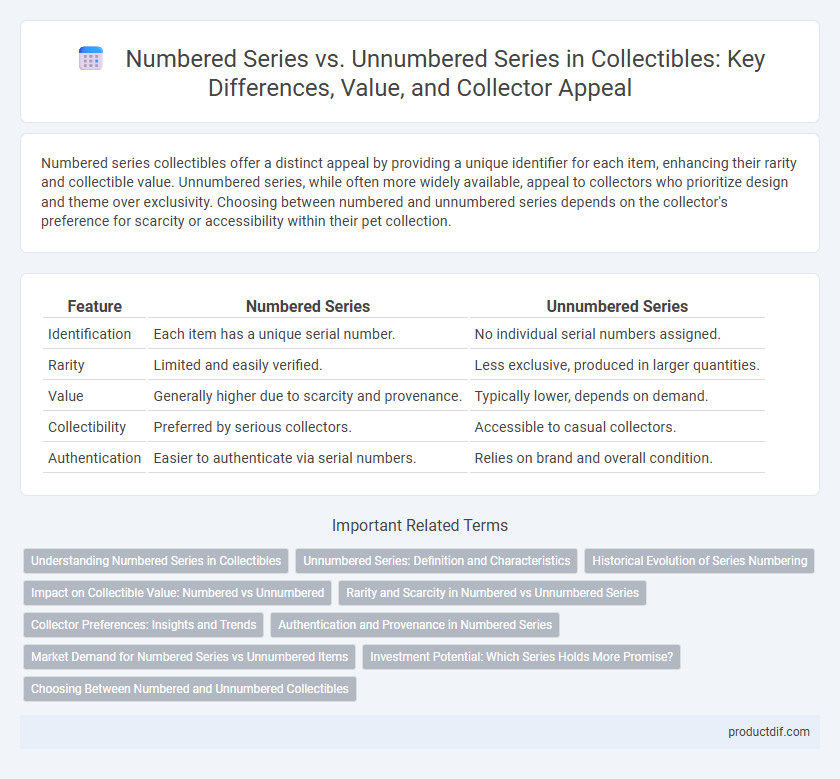Numbered series collectibles offer a distinct appeal by providing a unique identifier for each item, enhancing their rarity and collectible value. Unnumbered series, while often more widely available, appeal to collectors who prioritize design and theme over exclusivity. Choosing between numbered and unnumbered series depends on the collector's preference for scarcity or accessibility within their pet collection.
Table of Comparison
| Feature | Numbered Series | Unnumbered Series |
|---|---|---|
| Identification | Each item has a unique serial number. | No individual serial numbers assigned. |
| Rarity | Limited and easily verified. | Less exclusive, produced in larger quantities. |
| Value | Generally higher due to scarcity and provenance. | Typically lower, depends on demand. |
| Collectibility | Preferred by serious collectors. | Accessible to casual collectors. |
| Authentication | Easier to authenticate via serial numbers. | Relies on brand and overall condition. |
Understanding Numbered Series in Collectibles
Numbered series in collectibles feature a fixed quantity of items, each marked with a unique identifier such as 12/500, enhancing rarity and authenticity. Collectors often value numbered series higher due to their certified limited edition status and traceable production details. This exclusivity drives market demand, impacting resale value and desirability among collectors.
Unnumbered Series: Definition and Characteristics
Unnumbered series in collectibles refer to items produced without a unique identification number, making each piece indistinguishable in quantity from others in the same batch. These series often emphasize accessibility and uniformity rather than exclusivity or rarity, appealing to collectors seeking consistency or complete sets without the rarity premium. Characteristics include standardized designs, wide availability, and typically lower market value compared to numbered editions, although they can still hold significant collectible interest depending on the brand and cultural relevance.
Historical Evolution of Series Numbering
The historical evolution of series numbering in collectibles began as a method to authenticate and increase the value of limited editions by assigning unique numbers to each item. Numbered series emerged prominently in the mid-20th century, revolutionizing the collectibles market by enhancing rarity and demand through precise identification. Unnumbered series, while offering accessibility, often lack the provenance and market-driven exclusivity that numbered series provide to collectors.
Impact on Collectible Value: Numbered vs Unnumbered
Numbered series often hold higher collectible value due to their limited availability and explicit rarity, which appeals to collectors seeking exclusivity. Unnumbered series, while potentially valuable, lack precise scarcity indicators, reducing their perceived uniqueness and market demand. Provenance and condition also influence value but the numbering convention remains a key differentiator in collectible valuation.
Rarity and Scarcity in Numbered vs Unnumbered Series
Numbered series collectibles exhibit greater rarity due to their limited, explicitly defined quantities, which collectors highly value for scarcity and authenticity. Unnumbered series, while potentially produced in large volumes, lack precise accountability, diminishing their rarity and impacting market demand. Scarcity in numbered editions drives exclusivity and often results in higher collectible valuations compared to unnumbered counterparts.
Collector Preferences: Insights and Trends
Collectors often prefer numbered series for their rarity and verifiable authenticity, which enhances the collectible's value and appeal in the market. Unnumbered series may attract buyers seeking affordability and general aesthetic appeal without the pressure of scarcity. Current trends indicate a growing demand for limited edition numbered collectibles, driven by investment potential and exclusivity among serious collectors.
Authentication and Provenance in Numbered Series
Numbered series provide clear authentication and provenance through unique identifiers that verify each collectible's legitimacy and origin. This system enhances value by allowing collectors to trace the history and ownership of individual pieces with certainty. Unnumbered series lack this precise documentation, which can complicate verification and diminish collector confidence.
Market Demand for Numbered Series vs Unnumbered Items
Numbered series collectibles typically generate higher market demand due to their perceived scarcity and authenticity, which appeals to serious investors and dedicated collectors. Unnumbered items often lack this exclusivity, resulting in lower valuation and slower appreciation over time. Collectors prioritize numbered editions as these provide verifiable rarity and potential for greater resale value in niche markets.
Investment Potential: Which Series Holds More Promise?
Numbered series collectibles typically hold higher investment potential due to their verified rarity and traceable provenance, attracting serious collectors and increasing resale value. Unnumbered series lack specific identification, often making them less desirable in the secondary market and harder to authenticate. The scarcity and documented exclusivity of numbered series generally lead to stronger long-term appreciation and investment promise.
Choosing Between Numbered and Unnumbered Collectibles
Choosing between numbered and unnumbered collectibles depends on the collector's preference for exclusivity and potential value appreciation. Numbered series typically offer a fixed quantity, enhancing rarity and often increasing market demand over time. Unnumbered collectibles may provide greater availability but lack the unique identification that drives premium pricing in limited-edition markets.
Numbered Series vs Unnumbered Series Infographic

 productdif.com
productdif.com